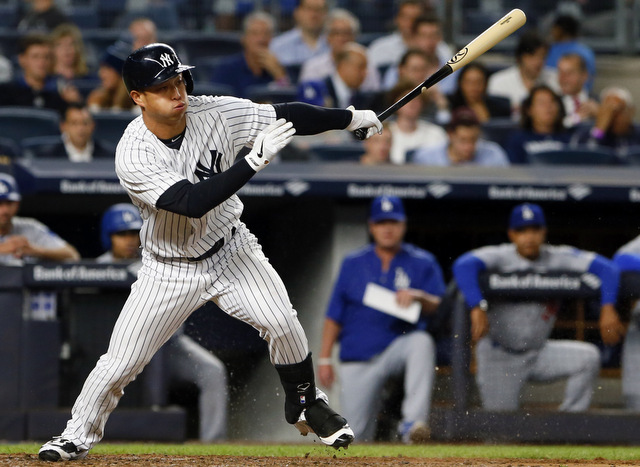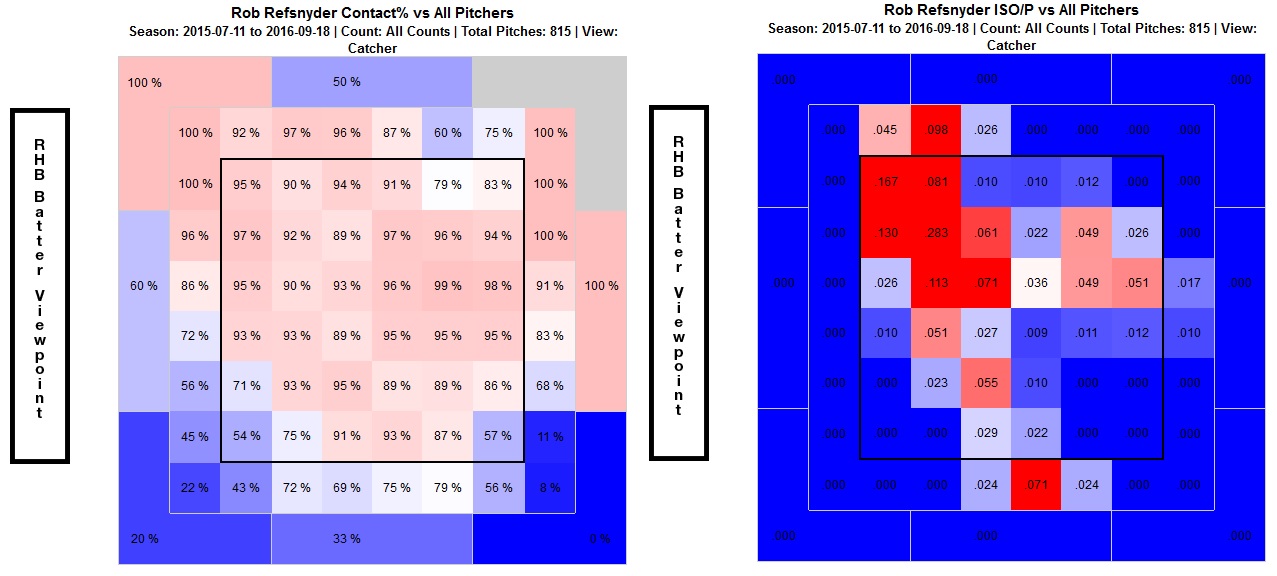
Since the trade deadline the Yankees have started a legitimate youth movement by calling up top prospects Gary Sanchez and Aaron Judge, as well as others like Tyler Austin and Ben Heller. Luis Cessa and Bryan Mitchell are in the rotation as well, though that’s largely due to necessity.
The one young player who predates all those guys is Rob Refsnyder, who was up briefly last season and has spent much of this year on the big league roster. He’s appeared in 54 games with the Yankees this season and figures to be a lineup regular the rest of the way thanks to the Starlin Castro and Jacoby Ellsbury injuries.
The 25-year-old Refsnyder has not had much of an impact at the plate this year, hitting .248/.334/.309 (70 wRC+) with zero home runs and only nine doubles in 171 plate appearances. He will work a walk (9.9%) and make contact (16.4% strikeouts), but not much more than that. For a bat-first (bat-only?) player, that’s not enough to stick around.
Refsnyder wants to change that. He wants to add some power to his game this offseason and he’s got a plan to make that happen. Here’s what Refsnyder told David Laurila over the weekend:
“I’m going to try to hit home runs next year,” Refsnyder told me on Friday. “I’ve had a lot of good conversations with people and I’m going to try to completely change my game. I think it will help my career.”
…
“I’m going to go back to the drawing board and watch a lot of video,” said Refsnyder. “I’ll probably watch a lot of (Brian) Dozier video. Dozier doesn’t have too long of a swing — he’s pretty short and compact — and his pull rate is really high. I’ll look at Daniel Murphy, too. He changed his game from being more of a contact guy — trying to put the barrel on the ball — to pulling the ball in the air.
“I’m never going to be one of those guys who hits for opposite-field power. That’s OK. Mookie Betts pulls the ball with the best of them. He goes the other way, but not for opposite-field home runs. Mookie and Dozier are the type of guys I need to look at.”
It’s an interesting thought, a non-power hitter trying to become a power hitter, and it’s not unprecedented. Refsnyder has identified the right guys to study — Dozier and Betts have both hit for far more power in the show than they were expected to in the minors — though as a right-handed hitter, he won’t benefit from the short porch by adopting their pull heavy approach. That doesn’t mean this isn’t worth trying though. I have some thoughts.
1. He needs to do more offensively to stick around. Simply put, Refsnyder will never be much of an asset in the field. He’s worked hard to pick up first and third base this season and that’s good. We haven’t seen him at third yet, but at least now Refsnyder’s an emergency option here. He’s spent plenty of time at first and second bases with the Yankees, and in the corner outfield.
The versatility is nice, but Refsnyder’s overall defense isn’t very good. It’s not even average, really. For him to have value and staying power in the big leagues, he’s going to have to hit and hit big. A bad defensive utility man with a .600-something OPS is not the most valuable player in the world, you know? No one expects Refsnyder to become a 40-homer guy like Dozier (seriously, wtf?), but getting to 15-20 homers would be huge.
2. He can cover the plate and drive inside pitches. There’s more to being a pull hitter than looking for a pitch inside and yanking it down the line. Pitchers aren’t stupid, they know when hitters are trying to pull the ball, which is why they’re going to stay on the outer half of the plate. For all their warts, Mark Teixeira and Brian McCann have been really good at punishing outside pitches the last few years.
As you might expect given his strikeout and contact (83.8%) rates, Refsnyder does a really nice job covering the plate. He can reach outside pitches and put them in the play. At the same time, he does his most damage on inside pitches, when he can whip the bat around and pull the ball to left. Here are some strike zone heat maps. Contact rate is on the left and ISO is on the right. You can click the image for a larger view and I recommend doing that so you can actually read it.
 The brighter the red the better, the brighter the blue the … worser? Anyway, the contact heat map (left) shows Refsnyder can get the bat on the ball no matter where it is in the strike zone, inside or outside, up or down. Down-and-in is his one glaring hole and that’s not uncommon at all. The ISO heat map (left) shows that while Refsnyder can make contact all around the strike zone, the inside pitch is the only one he’s been able to drive in his MLB career.
The brighter the red the better, the brighter the blue the … worser? Anyway, the contact heat map (left) shows Refsnyder can get the bat on the ball no matter where it is in the strike zone, inside or outside, up or down. Down-and-in is his one glaring hole and that’s not uncommon at all. The ISO heat map (left) shows that while Refsnyder can make contact all around the strike zone, the inside pitch is the only one he’s been able to drive in his MLB career.
Plate coverage is good! That’s a nice skill to have. Refsnyder’s ability to become a power hitter and hit more home runs is going to depend largely on whether he’ll be able to make consistent hard contact on pitches on the outer half. He had handle the inside pitch. The up-and-in pitch, to be more specific. Anything down and on the outer half of the plate is a different matter.
3. He needs to get the ball in the air more often. You’re not going to hit for power if you don’t hit the ball in the air, and so far this season Refsnyder has a 52.4% ground ball rate in the big leagues. It was 66.7% (!) last year. Here are his recent Triple-A ground ball rates:
2016: 53.9% in 230 plate appearances
2015: 59.2% in 522 plate appearances
2014: 53.2% in 333 plate appearances
Geez, that’s a lot of ground balls, huh? It’s no wonder Refsnyder hit only 35 home runs in just over 2,000 minor league plate appearances. He’s no Greg Bird when it comes to hitting the ball in the air. That’s for sure.
Moreso than driving outside pitches, figuring out how to get the ball in the air is going to be Refsnyder’s top priority as he works to hit for more power. This is a must. Only four players have a .170+ ISO and a 50%+ ground ball rate over the last three years: Ryan Braun, David Peralta, A.J. Pollock, and Hunter Pence. Step one to hitting more homers is getting the ball airborne. Refsnyder knows that, I’m sure.
4. The upside outweighs the downside. The thought of a hitter revamping his hitting style and approach in an effort to hit more home runs can be scary. There’s a lot of muscle memory in Refsnyder’s swing and he’s going to have to alter it. What if the power hitting fails and he screws up his normal swing? It could be a career-ender.
It’s easy for me to say this because it’s not my livelihood on the line, but I think this is worth a shot. The upside is greater than the downside. As it stands, Refsnyder is basically a utility guy who might not be average on either side of the ball, and that’s a tough profile. Hitting for more power can help keep him in the big leagues longer. He doesn’t have to turn into Brian Dozier, he just has to do more than he has been. His current skill set may not be built to last.
Leave a Reply
You must be logged in to post a comment.